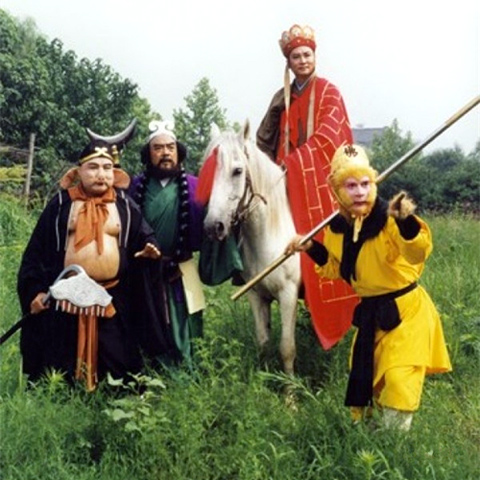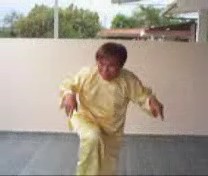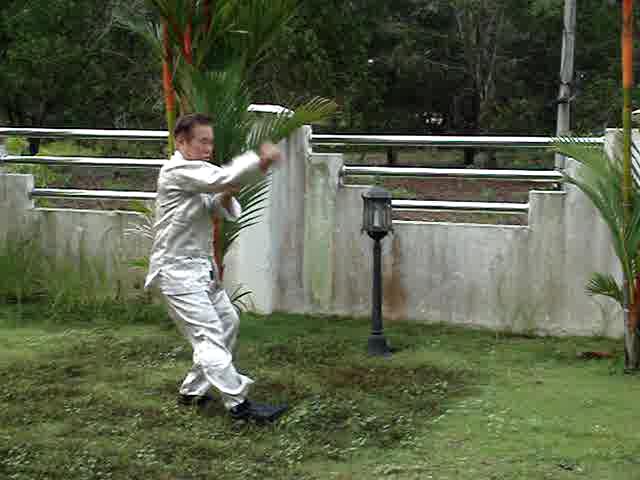SELECTION OF QUESTIONS AND ANSWERS
JUNE 2017 PART 3

Journey to the West, picture reproduced from http://www.moviexk.net/journey-west-1986
Question 1
Does Sifu mean that due to the fact that the majority of current living beings here now hold the conception of time being linear, that therefore even in the astral and higher planes this linearity is still in affect? Is there an inherent link between the way we experience the "forward" linearity of time and the actual unfolding of the Universe as it manifests in this realm?
— Jeremy, USA
Answer
As far as I know, in the astral and higher planes this linearity of time is still in effect. For example, in the famous Chinese classic, "Journey to the West", The Monkey God was first born from a gigantic rock that had been blessed by the sun and the moon. He then learned Taoist magic from a master who did not want to be known, and the divine monkey was named "Sun Wu Kong". Sun Wu Kong then created havoc in heaven.
The Jade Emperor bestowed the title "The Great Sage Equal to Heaven" on him. Later he was imprisoned by the Buddha beneath the Five-Finger Mountain.
The great monk, Xuan Zang, released him from imprisonment. Sun Wu Kong became a disciple of Xuan Zang and protected him to the West to bring Buddhist scriptures to China.
All these events occurred in a linear fashion.
In our phenomenal world, some scientists theorize that time could go backward in a manner not easily understandable by ordinary people. A sub-atomic particle, for example, could exist in the past in the next moment, instead of in the future. But this is still a theory.
I don't know how the actual unfolding of the Universe manifests in this realm. But according to cosmology, time as well as everything else do not exist in the perfectly transcendental dimension. If there is time, or anything else, it is no longer perfectly transcendental. It becomes phenomenal.
In other words, in the perfectly transcendental dimension, there is no Big Bang. There is also no sub-atomic particles traveling backward in time. The Big Band, the existence of sub-atomic particles irrespective of whether they travel forward or backward in time, and any worlds where time is cyclic, will transform the perfectly transcendental to phenomenal.
Question 2
If someone is in a group of stressful people, will he be influenced by them?
— Rena, Austria
Answer
Yes, he will be more stressed than if he were in a company where the people are not stresseful. The stress from the stressful people can influence him.
However, if his chi is very strong and good, he can influence the group instead. The stressful people will be less stressed than if he were not there.
The person with strong chi will have less strong chi at the end of his staying with stressful people than before. Some of his good chi will be absorbed by the other stressful people. However, if he is a master and his chi is very strong, it may not make much difference to him.
The master can also tap good chi from the Cosmos to replace his chi absorbed by the stressful people. The surrounding Cosmos will have both good chi and bad chi from the stressful people. But the master, if he has the necessary skills, can tap the good chi and avoid the bad chi. This may sound incredible to some people, but it is true.
An analogy is a tray with a variety of fruit, like pineapples, bananas, grapes and oranges. A person who has not made any previous choice may take any fruit from the tray, be it a pineapple, a banana, a grape or an orange. But a person with a choice may just pick the fruit he wants.
Hence, the answer is not definite. It depends on a number of other factors.

Before thinking of becoming a kungfu master, one must first become a good student
Question 3
I would like to become a kungfu teacher or/and chi kung healer. Can you tell me what I should do?
— Richard, Austria
Answer
Firstly, you should become a good student, not only in kungfu and chi kung but more importantly in daily life. That means you must be combat efficient, have good health and vitality, have high moral values and be peaceful and happy.
You seem to have some health problems. Your voice, for example, is lacking in vigor. You should overcome your health problems even before becoming a good student.
Although I am Westernized, I am still very traditional in Eastern culture. There are many capable people who are more senior than you. The seniours are appointed instructors before the juniors.
Question 4
It is good to know you are in excellent health! As always I am amazed by the number of secrets that you share on your website. I found some amazing secrets regarding the Monkey Style.
— Sifu Roeland Dijkema, Netherlands
Answer
I certainly owed my excellent health, as well as vitality and longevity to my daily practice of kungfu and chi kung. Of course I am very grateful to the divine, especially Bodhisattva Guan Yin, Immortal Li and the Monkey God, for their blessings not only for me but also for our Shaolin Wahnam family irrespective of the religion of the family members.
We are also sincere in sharing our secrets, which masters in the past and even now would keep for their selected disciples. We want to preserve the greatness of kungfu and chi kung, and without sharing secrets it would be difficult to achieve this purpose.

Monkey Style Kungfu
Question 5
In "Spiritual Monkey Emerges from Cave", do you flow along the bridge and keep in contact with the bridge, thus taming the opponent's hand and arm and striking at the same time?
Answer
You can flow along over the opponent's arm, or under it, or independent of his attacking arm depending on the combat situation. If the opponent is shorter than you, you may flow over his arm. If the opponent is taller than you, you may flow under his arm. In either case you must protect yourself with your other hand against possible counter-strikes.
Or you may move to his side away from his attacking and strike his ribs, about the same time he completes his attack.
Question 6
Would a Northern Praying Mantis exponent also use this method with the Mantis Paw? Or would he prefer to immediately grip the opponent and strike?
Answer
Like the Monkey exponent or any exponent, there should not be any fixed response for the Praying Mantis exponent. His response will depend on various factors.
He can use this method with his Mantis Paw, with his knuckles as the striking points. He may also grip the opponent's arm with his Mantis Paw and simultaneously strike. For his strike he can use a thrust fist, chopping fist, a horizontal palm strike in a yin or a yang manner, or any suitable attack.
His Mantis grip, however, is not firm like a Tiger Claw or an Eagle Claw. It is only temporary, and not combat ending. Its primary function is to temporarily hold the opponent's arm so that he can strike, which is combat ending.

Praying mantis Kungfu
Question 7
As Praying Mantis uses a lot of gripping, would Praying Mantis exponents benefit from practicing patterns like "Golden Leopard Cleanses Claws" or is this too "hard"?
Answer
Yes, Praying Mantis exponents, or any exponents, can benefit from practicing patterns like "Golden Leopard Cleanses Claws", but it is not necessary as this training is too "hard". Praying Mantis exponents can spend their time training more suitable force or skills for their chopping fist, thrusting punch, horizontal chopping palms, and seven-star kick.
It should be noted that the "Golden Leopard Cleanses Claws" is not too "hard" for Praying Mantis Kungfu in general, but too "hard" for the gripping with the Mantis Paw.
As mentioned earlier, the Mantis Paw is for temporarily holding an opponent's arm so that the Praying Mantis exponent can execute his combat-ending strike like a chopping fist, a thrust punch or a horizontal palm strike. Hence, it is not necessary to spend extra time to develop much force for this grip.
As a rough analogy, to drive your car you need to open the door of the car to get in. But you need not have to spend extra time lifting weights, for example, so that you have much force to open the door.
Question 8
In sparring, I find it sometimes difficult to avoid low sweeping kicks on my thigh executed from the opponent's front leg, when I am in a Bow-Arrow Stance. The kicks do not do any damage. In fact, I don't feel anything as there is not much force behind these fast close kicks, but they are quite low and fast, making it difficult to avoid.
Answer
These low sweeping kicks do not cause much damage on you because you have developed "Golden Bell", although you did not train "Golden Bell" formally. You developed "Golden Bell" spontaneously from your stance training.
If the attackers apply these sweeping kicks on other people, they would cause some damage. At least the sweeping kicks would cause these other people to be dazed for a moment, during which time the attackers could move in with their finishing strikes. This tactic is known as "tak sai pat lau yen", which means "if you gain an advantage in a combat situation, don't let your opponent escape."
If the sweeping kicks do not cause damage or do not daze opponents for the attackers to move in with their finishing strikes, the attackers should not use these sweeping kicks. This is because using these sweeping kicks will place the attackers in certain disadvantageous positions.
For example, the attackers will need time to recover themselves after the kicks, and during this recovering time, initiated opponents can counter-attack. While kicking, the attackers are not as balanced or flexible as when they are on two legs. At this time, their other striking points, like their hands, the other leg, their hips, their shoulders, their elbows and their head are not as functional as when they are in most other combat situations. Moreover, their kicking leg is exposed to counter-strikes.
Question 9
Could I ask you for advice on how to deal with these kicks? Just ignoring them is probably not the most elegant solution and I would prefer not to be hit at all.
Answer
If you understand the innate weaknesses of a kick, you can work out many counters. The weaknesses are innate, i.e. the weaknesses are necessarily incorporated in the kicking technique, and not because of any inadequacy of the attacker.
As the kicks do not cause you any damage, you can let the kick reach your body which will stop the kick, grip the kicking leg with one hand and strike it with your other hand. You should strike the leg with the knuckles of your other hand at a side of his shin, his knee or his upper leg.
Be careful that the opponent may hop in to strike you. If he does so, you may retreat your front leg to pull him to fall forward, then finish him off with a decisive strike. Or you may ward off his strike, and counter-strike his face, still holding his leg.
Another effective counter is to retreat your front leg from the Bow-Arrow Stance to a T-Step to let his sweeping kick pass you. Immediately move forward to fell him on the ground and finish him with a decisive strike.
A third way is to intercept his sweeping kick. Depending on the spacing, you can intercept his kick with the front leg or the back leg of your Bow-Arrow Stance. Use the sole of your leg to kick at the knee or thigh of the attacker as his sweeping leg is approaching. Immediately after intercepting, kick him with a frontal thrust kick or a side kick. You may have to jump in to kick him.
Another effective counter is to move diagonally forward in the other direction and simultaneously strike or kick him as he kicks.
Suppose you are at a right Bow-Arrow Stance, and your opponent kicks at your right thigh with his left sweeping kick. Move diagonally with your back left leg and kick his groin with your right leg, or strike his ribs with your right leopard fist.
If your opponent kicks your right leg or body with his right sweeping kick while you are at a right Bow-Arrow Stance, move diagonally forward to your right side with your right front leg, and kick his groin with your left leg or strike his ribs with your left leopard fist.
You are at a left Bow-Arrow Stance, and your opponent kicks at your thigh or body with his right sweeping kick. Move diagonally forward with your back right leg, and kick his groin with your left leg or strike his ribs with your left leopard fist.
You are at a left Bow-Arrow Stance, and your opponent kicks at your thigh or body with his left sweeping kick. Move your front left leg to your left, and kick at his groin with your right leg or strike his ribs with your right leopard fist.
You must practice all these movements with an imaginary opponent. Only when you have become very fluent with the movements, should you apply them on your opponent. In an actual free sparring, as soon as your opponent applies his sweeping kick, you will defeat him with your planned movements.
LINKS
Selected Reading
- Bringing Out the Best in People
- Seeing the World as I Never Could Before
- Taijiquan Defence against Fundamental Attacks
- Shaolin Monkey Set
- The Grand Canyon
